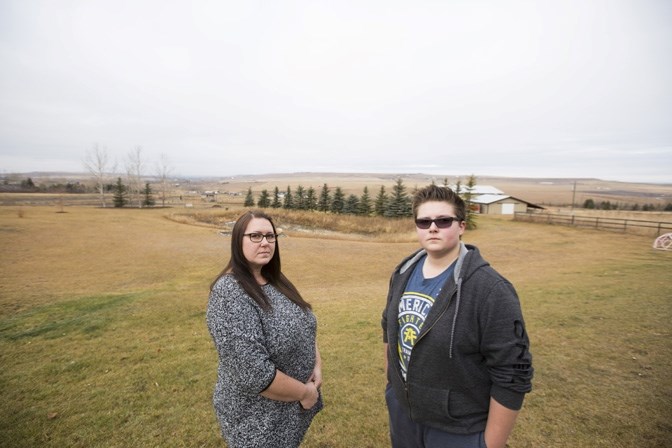One Foothills family is feeling disconnected in their home near the Big Rock.
The Holungas have experienced intermittent Internet service since moving onto their acreage home west of Okotoks nine years ago and feel their options have been exhausted.
“We hear over and over again we’re not in the line of sight of local towers,” said Tammy Holunga.
In 2006, the Holungas received satellite service at $180 per month, but the connection was less reliable than dial-up connections for an enormous price tag, she said.
The Holungas aren’t alone. Poor Internet service is a problem many in rural areas face, but it’s something Internet providers and the federal government are working to improve.
Two years ago, Holunga asked Platinum Communications – a provider of rural Internet services currently being bought by Xplornet – to visit the home. It was determined the east Priddis communications tower could just be seen from the rooftop of their home.
“We have two dishes aimed at that tower, but if the wind blows and a tree leaf gets between our house and the tower, our service goes down,” said Holunga.
Their connection may be lost for anywhere from one hour to several days, she said, which causes issues for the family in a largely online world.
Though their current connection is considered high-speed, Platinum Communications can’t guarantee the speed, she said, because of the tower location. As a result, their service may be sufficiently fast and then slow to a crawl or fail completely.
“Everything is online these days, from paying bills to a lot of communication and business and my kids’ video games,” said Holunga. “We feel like it’s a necessity.”
The family has worked to improve their situation, even offering to have Platinum Communications build a tower on their land to improve service for their area, she said.
Though they felt they had gained some traction from one year ago, plans for Xplornet to buy Platinum put all thoughts of construction on hold, she said.
With over one hundred homes in the surrounding area, Holunga said she doubts her home is alone in this situation.
Geoff Bowerman, manager of telecommunications infrastructure for Platinum Communications, has visited the Holunga home to discuss their issues. It was Bowerman who discovered the house could be connected to the Priddis tower two years ago.
“It’s a very site-specific issue,” he said. “Foliage and terrain can always be a factor when we’re talking about rural connections and unfortunately the reality is that we can’t reach everybody in the foothills.”
Bowerman said he believes there is hope for the Holunga family and other households experiencing similar issues, as Xplornet has committed to better satellite coverage within the next two years.
He said the satellite feed should reach all residents, whether in valleys like the Holungas or on hillsides out of sight of towers.
Xplornet, which touts itself as “Canada’s leading rural broadband Internet provider,” intends to improve its service to make the online world more accessible to its customers.
The company has been upgrading its satellites to a 4G network for the past two years, according to senior vice president of business development Bill Mcdonald.
“The new satellite network runs around $80 to $90,” he said. “It’s bringing far higher speeds for lower cost.”
Xplornet intends to launch new satellites in 2016 as well as updating the current Platinum Communications towers, he said. The company will also introduce a tower-based long-term evolution (LTE) system.
Both the new LTE and satellite networks will enhance Internet service for rural customers, with a download rate of 25 Mb/s, he said. The rate of the previous LTE system was 10 Mb/s.
Mcdonald said Xplornet is catching up to the demand placed on its current system as quickly as it can.
“I don’t think there’s a time when the expectation for faster Internet will ever stop,” he said. “Getting entertainment, TV and media online, puts more pressure on the system and makes it difficult to keep up.”
Mcdonald said Xplornet does not rely on private or public sector funding, but would appreciate government help to make Internet services more affordable for rural customers and ease the demand.
“We’re trying to work with governments to get involved and create a level playing field between urban and rural Internet connections,” he said.
According to Foothills MP John Barlow, the Connecting Canadians program initiated by the Harper government in 2014 committed $300 million to bring high-speed rural broadband service to communities across the country.
The government saw disparity between communities who could access service and those who could not and the funding was provided to help bridge that gap, he said.
Funding was not given to providers, but to municipalities who applied to access dollars for broadband infrastructure, he said.
“Most people in Okotoks or High River assume most people have access to high speed Internet,” said Barlow. “The reality is, if you’re living in Bragg Creek or say you’re a student in Millarville trying to do homework, it’s possible you don’t have that access.”
Barlow said without the infrastructure to provide high speed Internet to rural communities, certain businesses may stay away from small municipalities or rural areas.
“It’s a necessity,” he said. “It is a utility just like electricity, like water. People need access to do business, to do homework, to live in this society.”
The first round of approvals were initiated last fall, he said, and southeast B.C. was approved. Barlow had been hoping Crowsnest could tag on and bring in more high speed Internet service.
The MD of Foothills also intended to apply, he said.
“We’ll have to see if the new government continues to support our initiative,” he said. “I’m not sure what the future of Connecting Canadians will be.”




